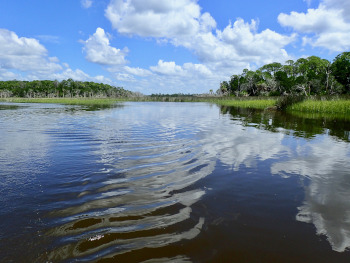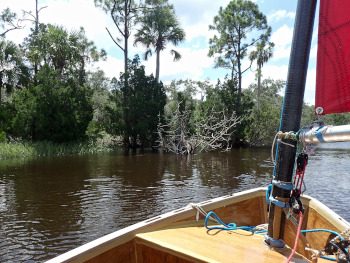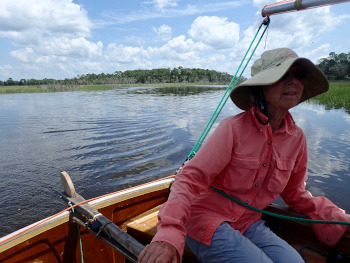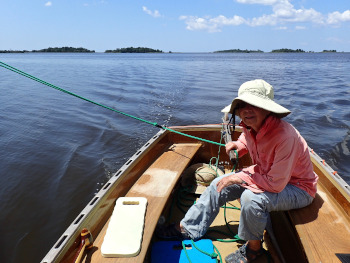Raleighs' "Quiet" Whelk Worlds
 How could Karen and I have forgotten the pre-Columbian beads and tools made from snails' shells,
the "left-opening, clockwise," Lightning Whelk? We had tried to sail through the Raleigh Islands three
times, but, Karen was north when conditions were right again. On my second solo try I finally made it. A
month later, we sailed through twice. Each time we forgot the islands' aborigines and their "shell rings"; we
forgot their whelk beads made 700 to 900 years ago.
How could Karen and I have forgotten the pre-Columbian beads and tools made from snails' shells,
the "left-opening, clockwise," Lightning Whelk? We had tried to sail through the Raleigh Islands three
times, but, Karen was north when conditions were right again. On my second solo try I finally made it. A
month later, we sailed through twice. Each time we forgot the islands' aborigines and their "shell rings"; we
forgot their whelk beads made 700 to 900 years ago.
Archeology professor, Ken Sassaman, of the University of Florida, told me of his and graduate students' last nine years research in the Lower Suwannee National Wildlife Refuge. Shell rings, Sassaman said, are "... places of circular habitation around which shell and other refuse accumulated."
The wooded Raleighs seem remote from the vibrant coast of the Cedar Keys and Lower Suwannee Refuges. The largest of the ten islands is nearly a mile long, eighty acres; the others are from two acres to thirty. They fit into two square miles of salt marsh with creeks crossing a mile through them.
 For us, besides fascinating archeology, the Raleighs had become a near obsession. In sailing canoe Bufflehead,
at a higher high tide, we'd only peered into them from upper drainages. In dinghy Clam Girl, too, we'd
stared into them from the west. They were the essence of a place one has gazed into, an island or grove, and
wondered, 'What's it like in there?'
For us, besides fascinating archeology, the Raleighs had become a near obsession. In sailing canoe Bufflehead,
at a higher high tide, we'd only peered into them from upper drainages. In dinghy Clam Girl, too, we'd
stared into them from the west. They were the essence of a place one has gazed into, an island or grove, and
wondered, 'What's it like in there?'
August 1st it was sunny at 10:30, four hours before the higher high tide. I was leery of the breeze, but, the northeasterly seemed okay at the Shell Mound ramp, maybe four to six knots, enough compared to the pre- vious day's three to two to zip.
 Clam Girl and I gently close reached north with staccato clacks rising from the marshes - elusive Clapper
Rails. In a quarter mile the breeze had fallen to four to three knots southeast, and dolphins' breathing seemed
close over glassy shallows. Basins narrowed to meandering creeks.
Clam Girl and I gently close reached north with staccato clacks rising from the marshes - elusive Clapper
Rails. In a quarter mile the breeze had fallen to four to three knots southeast, and dolphins' breathing seemed
close over glassy shallows. Basins narrowed to meandering creeks.
At every branch, I took the one with more current. I knew, from satellite photos, Clam Girl must pass close to the biggest Raleigh. Sailing - and smiling at the rails, fish trails and frog splashes - engaged me.
 After the first meander dead ended at the island, I backtracked, crossing a divide, and paddling up current
into a maze of twisting creeks.
After the first meander dead ended at the island, I backtracked, crossing a divide, and paddling up current
into a maze of twisting creeks.
The breeze came back southwesterly enough to re-set the sail, and a meander took Clam Girl within a few yards of an old cedar toppled from the shore. Then, at my eye level, as I reveled in the serenity, an Anhinga burst flapping and disheveled from the cedar.
Clam Girl tacked and gybed up current at a crawl through the winding creeks. A Frigate Bird soared.
However, just to get out of Preacher Hole I was challenged beating into the light southwesterly and the still-coming flood. Spectating dolphins and egrets might have muttered, "That one-winged plump thing going back and forth... is it hurt?"
Driving away from the ramp, I realized the four hours' journey had been such a jolly good boat ride, so en- grossing, I'd forgotten archeology and the long-gone natives.
 Karen returned for more of the higher high tides. With northerlies the 29th and a gusty easterly the 31st, we
sailed with the flood up into Preacher Hole, the reverse of my route. The first day an eagle's white tail
flashed over the trees, and - a rare sight - a Clapper Rail flew a few yards, skimming over the marsh grass.
I'd thought the turns into the marsh were the same the second day, but we came from a different meander to
the fallen cedar, then into the maze. Both days, searching for the way out to the west, the breeze failing, the
current became ever lighter against us.
Karen returned for more of the higher high tides. With northerlies the 29th and a gusty easterly the 31st, we
sailed with the flood up into Preacher Hole, the reverse of my route. The first day an eagle's white tail
flashed over the trees, and - a rare sight - a Clapper Rail flew a few yards, skimming over the marsh grass.
I'd thought the turns into the marsh were the same the second day, but we came from a different meander to
the fallen cedar, then into the maze. Both days, searching for the way out to the west, the breeze failing, the
current became ever lighter against us.
We were not reminded, though, of the culture that had made the whelk beads, likely traded into Alabama and Georgia. Nor had we seen any of the Raleighs' thirty seven shell rings, thirty to two hundred feet wide. But, if we'd wanted to look, a small NWR sign says, "UNAUTHORIZED ENTRY PROHIBITED." We don't want to disturb archeological sites, anyway, and I profoundly didn't want to excite yellow flies, waiting in the shade
 Were whelk beads simply baubles, or, bound with cultural superstition, like other beaded necklaces, cross-
ing time and culture? Can we imagine a necklace of Raleigh Islands' beads given to flatter a chief, maybe,
or please a beaming girl, 800 years ago, hundreds of miles from Cedar Key?
Were whelk beads simply baubles, or, bound with cultural superstition, like other beaded necklaces, cross-
ing time and culture? Can we imagine a necklace of Raleigh Islands' beads given to flatter a chief, maybe,
or please a beaming girl, 800 years ago, hundreds of miles from Cedar Key?
Sir Walter Raleigh wrote, "Give me my scallop shell of quiet." Personal peace seemed out of his grasp - he lost his head to royal intrigue. I wish he could have had the tranquility we did in his namesake islands.
~HH
- Closely related: Marsh Maze Madness